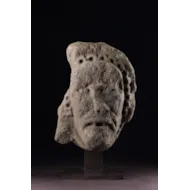Ancient British Celtic Carved Gritstone Panel Head of a Deity
An Ancient British Celtic Carved Gritstone Panel Head of a Deity
The open mouth showing teeth and a hole to the centre possibly for offerings spectacled oval eyes a mass of hair shown around the head with a series of holes and a deformed long nose
1st Century BC – 1st Century AD
Size: 28cm high, 20.5cm wide, 10cm deep - 11 ins high, 8 ins wide, 4 ins deep / 34.5cm high - 13½ ins high (with base)
The open mouth showing teeth and a hole to the centre possibly for offerings spectacled oval eyes a mass of hair shown around the head with a series of holes and a deformed long nose
1st Century BC – 1st Century AD
Size: 28cm high, 20.5cm wide, 10cm deep - 11 ins high, 8 ins wide, 4 ins deep / 34.5cm high - 13½ ins high (with base)
An Ancient British Celtic Carved Gritstone Panel Head of a Deity
The open mouth showing teeth and a hole to the centre possibly for offerings spectacled oval eyes a mass of hair shown around the head with a series of holes and a deformed long nose
1st Century BC – 1st Century AD
Size: 28cm high, 20.5cm wide, 10cm deep - 11 ins high, 8 ins wide, 4 ins deep / 34.5cm high - 13½ ins high (with base)
The open mouth showing teeth and a hole to the centre possibly for offerings spectacled oval eyes a mass of hair shown around the head with a series of holes and a deformed long nose
1st Century BC – 1st Century AD
Size: 28cm high, 20.5cm wide, 10cm deep - 11 ins high, 8 ins wide, 4 ins deep / 34.5cm high - 13½ ins high (with base)
The Celts venerated the head as a symbol of divinity and the powers of the otherworld. They regarded it as the most important part of the human body, the very seat of the soul. Although this veneration had an ancestry in Europe and Britain far older than the Celts, it was they who developed it into an elaborate cult and made it a distinctive feature of their religious expression.
It is known from the skulls found in Celtic iron age hill forts that human heads were hunted and that these served as trophies testifying to the military prowess of their owner and simultaneously acted protectively in keeping evil away from the fortress whilst ensuring positive success and good luck. Thus the symbol of the severed human head became as representative of the Celtic religion as is the cross in Christian contexts.
It is known from the skulls found in Celtic iron age hill forts that human heads were hunted and that these served as trophies testifying to the military prowess of their owner and simultaneously acted protectively in keeping evil away from the fortress whilst ensuring positive success and good luck. Thus the symbol of the severed human head became as representative of the Celtic religion as is the cross in Christian contexts.
Ex Private Yorkshire collection
cf: A similar head showing teeth in the Cartwright Hall Museum, Bradford unearthed in a garden
cf: A similar head showing teeth in the Cartwright Hall Museum, Bradford unearthed in a garden
Ancient British Celtic Carved Gritstone Panel Head of a Deity

SOLD






